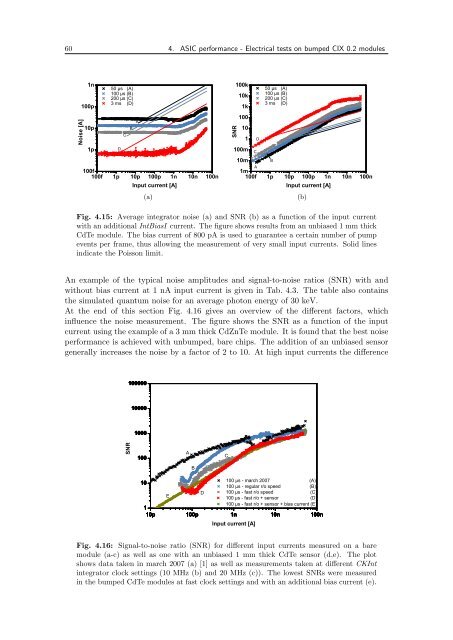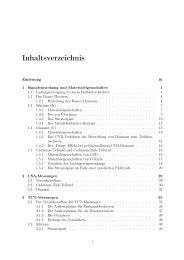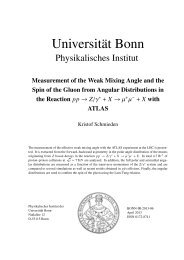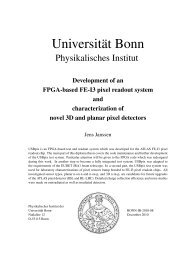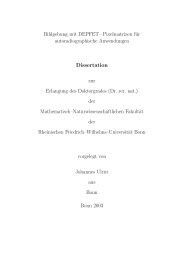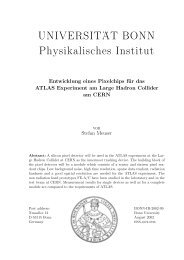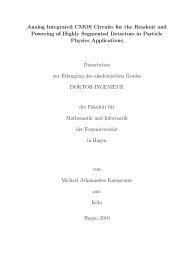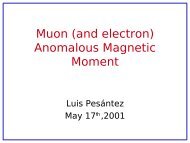UNIVERSIT . . AT BONN Physikalisches Institut - Prof. Dr. Norbert ...
UNIVERSIT . . AT BONN Physikalisches Institut - Prof. Dr. Norbert ...
UNIVERSIT . . AT BONN Physikalisches Institut - Prof. Dr. Norbert ...
You also want an ePaper? Increase the reach of your titles
YUMPU automatically turns print PDFs into web optimized ePapers that Google loves.
60 4. ASIC performance - Electrical tests on bumped CIX 0.2 modules<br />
N o is e [A ]<br />
1 n<br />
1 0 0 p<br />
1 0 p<br />
1 p<br />
������������<br />
�����������<br />
�����������<br />
������������<br />
�<br />
�<br />
�<br />
�<br />
1 0 0 f<br />
1 0 0 f 1 p 1 0 p 1 0 0 p 1 n 1 0 n 1 0 0 n<br />
In p u t c u r r e n t [A ]<br />
(a)<br />
S N R<br />
1 0 0 k<br />
1 0 k<br />
1 k<br />
1 0 0<br />
1 0<br />
1 0 0 m<br />
1 0 m<br />
1<br />
�<br />
�<br />
�<br />
������������<br />
�����������<br />
�����������<br />
������������<br />
�<br />
1 m<br />
1 0 0 f 1 p 1 0 p 1 0 0 p 1 n 1 0 n 1 0 0 n<br />
In p u t c u r r e n t [A ]<br />
Fig. 4.15: Average integrator noise (a) and SNR (b) as a function of the input current<br />
with an additional IntBiasI current. The figure shows results from an unbiased 1 mm thick<br />
CdTe module. The bias current of 800 pA is used to guarantee a certain number of pump<br />
events per frame, thus allowing the measurement of very small input currents. Solid lines<br />
indicate the Poisson limit.<br />
An example of the typical noise amplitudes and signal-to-noise ratios (SNR) with and<br />
without bias current at 1 nA input current is given in Tab. 4.3. The table also contains<br />
the simulated quantum noise for an average photon energy of 30 keV.<br />
At the end of this section Fig. 4.16 gives an overview of the different factors, which<br />
influence the noise measurement. The figure shows the SNR as a function of the input<br />
current using the example of a 3 mm thick CdZnTe module. It is found that the best noise<br />
performance is achieved with unbumped, bare chips. The addition of an unbiased sensor<br />
generally increases the noise by a factor of 2 to 10. At high input currents the difference<br />
1 0 0 0 0 0<br />
S N R<br />
1 0 0 0 0<br />
1 0 0 0<br />
1 0 0<br />
�<br />
�<br />
�<br />
(b)<br />
1 0<br />
�����������������������������������������������������<br />
����������������������������������������������������<br />
�<br />
� �������������������������������������������������������<br />
������������������������������������������������������<br />
1<br />
����������������������������������������������<br />
1 0 p 1 0 0 p 1 n 1 0 n 1 0 0 n<br />
In p u t c u r r e n t [A ]<br />
Fig. 4.16: Signal-to-noise ratio (SNR) for different input currents measured on a bare<br />
module (a-c) as well as one with an unbiased 1 mm thick CdTe sensor (d,e). The plot<br />
shows data taken in march 2007 (a) [1] as well as measurements taken at different CKInt<br />
integrator clock settings (10 MHz (b) and 20 MHz (c)). The lowest SNRs were measured<br />
in the bumped CdTe modules at fast clock settings and with an additional bias current (e).


